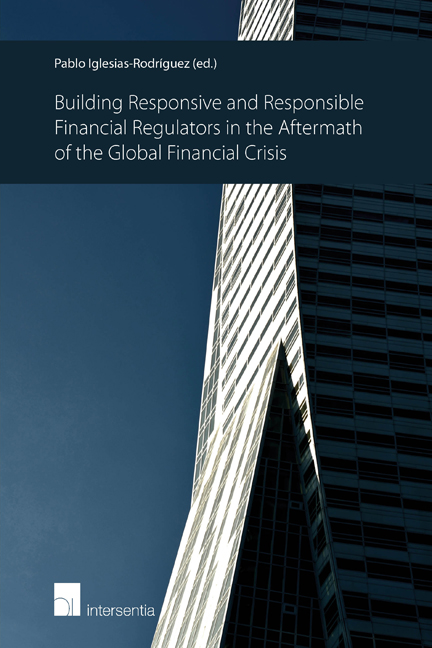Book contents
- Frontmatter
- Preface and acknowledgements
- Foreword
- Contents
- List of contributors
- Responsive-and-responsible financial regulation in the aftermath of the global financial crisis
- Part I THE CONTRIBUTION OF ACCOUNTABILITY, INDEPENDENCE AND ECONOMIC THEORY TO RESPONSIVE-AND-RESPONSIBLE FINANCIAL REGULATION
- Part II POST-CRISIS ARCHITECTURES OF FINANCIAL REGULATION IN THE EUROPEAN UNION, THE UNITED STATES OF AMERICA AND CANADA: ACCOUNTABILITY AND RESPONSIVENESSAND- RESPONSIBILITY
- Part II. 1 THE EUROPEAN UNION
- Part II. 2 THE UNITED STATES OF AMERICA
- Financial stability rearticulated: institutional reform, post-crisis governance and the new regulatory landscape in the United States
- The Financial Industry Regulatory Authority: not self-regulation after all
- Part II. 3 CANADA
The Financial Industry Regulatory Authority: not self-regulation after all
from Part II. 2 - THE UNITED STATES OF AMERICA
Published online by Cambridge University Press: 26 November 2017
- Frontmatter
- Preface and acknowledgements
- Foreword
- Contents
- List of contributors
- Responsive-and-responsible financial regulation in the aftermath of the global financial crisis
- Part I THE CONTRIBUTION OF ACCOUNTABILITY, INDEPENDENCE AND ECONOMIC THEORY TO RESPONSIVE-AND-RESPONSIBLE FINANCIAL REGULATION
- Part II POST-CRISIS ARCHITECTURES OF FINANCIAL REGULATION IN THE EUROPEAN UNION, THE UNITED STATES OF AMERICA AND CANADA: ACCOUNTABILITY AND RESPONSIVENESSAND- RESPONSIBILITY
- Part II. 1 THE EUROPEAN UNION
- Part II. 2 THE UNITED STATES OF AMERICA
- Financial stability rearticulated: institutional reform, post-crisis governance and the new regulatory landscape in the United States
- The Financial Industry Regulatory Authority: not self-regulation after all
- Part II. 3 CANADA
Summary
The Financial Industry Regulatory Authority (FINRA) is the front-line regulator of broker-dealers in the United States. FINRA is not the self-regulatory organization some imagine it to be. A self-described ‘independent’ regulator, FINRA is a non-governmental, not-for-profit organization that wields considerable control over the daily activities of its member firms, their employees, and the investors they serve. The U.S. Securities and Exchange Commission (SEC) – the governmental regulator of the securities markets – oversees FINRA, but FINRA enjoys considerable independence. On the one hand, its governance structure means that it is not accountable to the industry it regulates in the way an SRO would be. On the other hand, FINRA's broad governmental powers are not paired with the public accountability measures to which governmental regulators are subject. Concerns about FINRA's lack of accountability loom even larger as FINRA seeks to regulate additional facets of the financial markets such as investment advisers and securities markets. Policymakers should reconsider its growing role in light of its lack of accountability to the industry it regulates and to the public it is supposed to serve.
The chapter proceeds as follows. Part 1 discusses the history and responsibilities of FINRA and its predecessor the National Association of Securities Dealers (NASD). Part 2 discusses FINRA's current functions. Part 3 sets forth the structure of accountability within which FINRA operates. Part 4 compares the mechanisms by which governmental regulators are held accountable to the public with FINRA's accountability structure. Part 5 discusses recent changes in FINRA's focus and aspirations. Part 6 concludes with a recommendation that FINRA's role in the regulation of the U.S. securities markets be reconsidered in order to achieve more effective and accountable financial regulation.
THE EMERGENCE OF FINRA
FINRA, which was formed in 2007, was built upon a long tradition of self-regulatory organizations (SROs) in the securities industry. FINRA's predecessor, the NASD, joined the ranks of SROs in the late 1930s. Self-regulating securities exchanges were already the industry norm when Congress created the Depression-era federal securities framework. They regulated member conduct and market activity and set standards for listed companies. The Securities Exchange Act of 1934 (Exchange Act) recognized and relied on exchange SROs, such as the New York Stock Exchange (NYSE), to continue performing these regulatory functions.
- Type
- Chapter
- Information
- Building Responsive and Responsible Financial Regulators in the Aftermath of the Global Financial Crisis , pp. 233 - 252Publisher: IntersentiaPrint publication year: 2015



